Call the medics
Injuries are all the vogue for England's cricketers at present. If it's not Michael Vaughan's knee, it's Ashley Giles's hip or even Ed Joyce's ankle. Here, Cricinfo charts a selection of players whose medical bulletins have been known to overtake the onfi
|
|
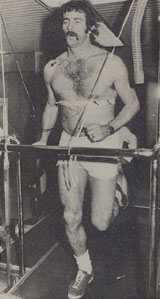
|
Lillee's emergence as a world-class fast bowler seemed to be over before it had really begun when he broke down on Australia's 1972-73 tour of the Caribbean after a year of suffering from back problems. An X-ray revealed three fractures on two of his lumbar vertebrae and it took a year of treatment - including months in plaster casts - and a remodelling of his action before he was able to return. The story goes that England's players went to watch him in the nets ahead of the 1974-75 Ashes series as he started on his comeback and left after a few minutes, convinced he was a shadow of his former self. He took 25 wickets in that series as England, routed 4-1, were destroyed by the pace and hostility of Lillee and Jeff Thomson.
If you think that Ronaldo's waistline occupies more column inches than it should, back in the 1950s it was Compton's knee that was the constant centre of attention. He originally suffered the injury playing for Arsenal against Charlton in 1938, but from the late 1940s onwards it increasingly hampered Compton, who was sport's first genuine marketing commodity and therefore highly newsworthy. In 1950 he underwent major surgery and in 1955, in a final desperate attempt to keep playing, he had his kneecap removed (it is now in a biscuit tin in the Lord's museum). Few believed he would return, but after a summer of daily newspaper updates, he did, fittingly, in the final Test against Australia as England retained the Ashes. It is a mark of his genius that despite being in almost constant pain and with movement limited after the 1950 operation, he still averaged over 42 in his last 41 Tests.
The hero (or villain, depending on which hemisphere you come from) of Bodyline, Larwood's career ended with the final Test of that series at Sydney. In Australia's second innings, his body finally gave way after months of pounding in on rock-hard Australian pitches and he broke down with a splintered bone in the ball of his left foot. Douglas Jardine refused to allow the hobbling Larwood to leave the field until Bradman had been dismissed. Although only 28, he did not play Test cricket again, and was never the same bowler, suffering on hard grounds when the pain in his foot returned. His efforts were not helped by a lifeless home surface at Trent Bridge, and the inevitable behind-the-scenes politics that were part and parcel of the Bodyline fall-out.
|
|
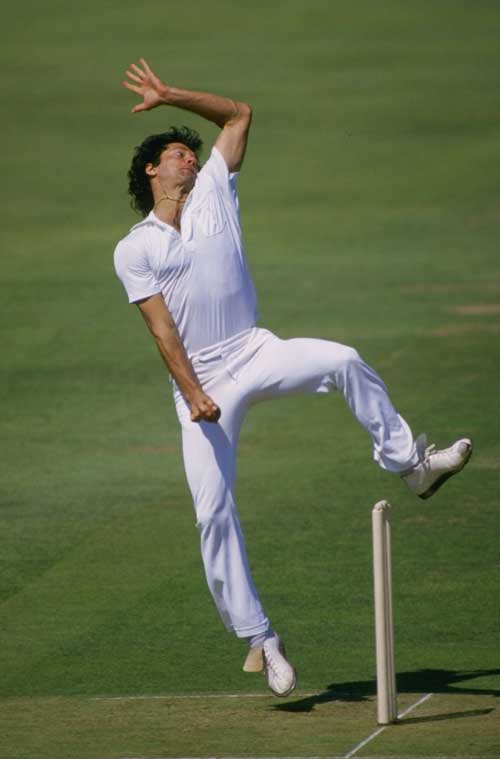
|
Pakistan's most successful and glamorous cricketer suffered from stress fractures of his left shin which kept him out of action for almost two years in the mid-1980s - and his rehabilitation was not helped by some less-than-accurate medical advice and a ludicrously slow diagnosis. Doctors for some time treated the injury as no more than bad bruising but, eventually, "new X-rays revealed a huge crack in my shin bone. The specialist said it was one of the worst cases of stress fracture he had ever seen: he was amazed that the bone had not shattered completely under the pressure I had placed on it." He had just taken 40 wickets in a series against India. He finally returned at a reduced pace, but with as much success as ever.
After the litany of metatarsal injuries that have befallen their footballers in recent years, England's fans probably believe they are the most anatomically knowledgable sports followers in the world. Tendulkar's devotees, on the other hand, all 1 billion of them, might beg to differ. In his long and illustrious career, Tendulkar had missed just three Tests and 45 ODIs in 15 years, but when tennis elbow struck in 2004, it ruled him out of a host of high-profile contests, including the Champions Trophy and the sharp end of a Test series against Australia. "There was a stage when I could not hold the bat properly, could not lift it at all," he admitted while travelling to London for an operation in May 2005, as India held its breath and their sports pages turned into medical journals.
|
|
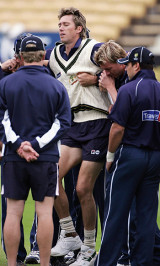
|
The turning point of the 2005 Ashes - quite literally. Australia were 1-0 up on the morning of the Edgbaston Test, and McGrath was in some of the best form of his illustrious career, having just routed England in a spell of 5 for 2 in 31 balls at his favourite overseas venue, Lord's. But with little more than half-an-hour to go before the toss, as the Australians warmed up with a game of touch rugby, McGrath stood on a stray cricket ball, turned his ankle nastily, and had to be carted off the pitch on the groundsman's buggy, and away to hospital. His place was taken by Michael Kasprowicz, and Australia's problems were compounded when Ricky Ponting won the toss and chose to bowl first regardless. Freed from McGrath's tyranny, England romped to 407 runs in a single day, and for all that the Aussies so nearly clawed back their lost ground, the momentum of the summer had shifted irrevocably.
Australia had suffered no such momentum issues four years earlier, however. On that occasion, the series had been signed and sealed in just 11 days' of one-sided hostilities, and Australia's only remaining incentive was to wrap up their first Ashes whitewash since 1920-21. So long as Waugh's flinty gaze was watching over the proceedings, that prospect was scarcely in doubt. But then he pushed at his first delivery of the second innings at Trent Bridge, hobbled to the end of the pitch in agony, and had to be helped from the pitch by the physio Errol Alcott. Waugh had suffered a torn calf muscle and it seemed his valedictory tour of England would end in personal disappointment. But then Australia, under Adam Gilchrist, lost the fourth Test at Headingley after a generous declaration, and Waugh resolved to return for the Oval showdown. He was barely match-fit but his single-mindedness carried him through the pain barrier and all the way to a brilliant unbeaten 157. It was one in the eye of the likes of Graham Thorpe and Michael Vaughan, who had suffered arguably lesser injuries but played just one Test between them.
|
|
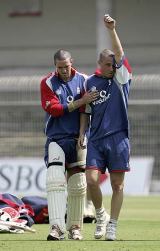
|
By rights, Jones's career should have been over when he wrecked his knee in that gruesome fielding incident at Brisbane in 2002-03. After coming to grief on the Gabba's sandy turf, he was out of action for 18 months, but returned fitter and more skilful than ever before, with a mastery of reverse-swing that few had believed he possessed. Having captured 18 wickets in four Ashes Tests last summer, he was voted the ninth sexiest man in the world by the newly cricket-literate readers of New Woman magazine. But that performance now seems set to be his epitaph. Since missing the Oval Test, Jones has suffered an unrelated injury to his left knee, leading Shane Warne (someone who's never been afraid of a spare tyre or two) to question whether he is too fit to be match fit. It may just be that he's been born under a lucky star - his father, Jeff, also had his career cut short by injury.
Bishop's emergence as a bowler of genuine pace came in the late 1980s, at just the right time for West Indies as their old fast-bowling vanguard faded. But what promised to be a great career was constantly blighted by injuries. Tall and lean, in 1991 he suffered stress fractures of the vertebrae, but, like Lillee, hard work and a remodelled action enabled him to return with less speed but comparable potency. However, he again crumbled in 1993 and thereafter his appearances became rarer still. In 1998, still only 30, he abandoned an increasingly uneven battle for fitness and moved to the less gruelling environment of the commentary box.
|
|
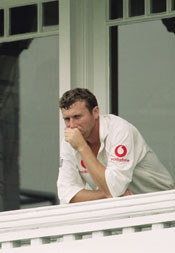
|
There were many remarkable aspects to Atherton's 12-year international career, but none more remarkable than the fact that he had a career at all. He was diagnosed with ankylosing spondylitis, a degenerative disease which causes the gradual curvature of the spine and also ended the footballing career of Atherton's father. After an excruciating series against West Indies in 1991 he underwent spinal surgery that winter, but despite a constant diet of pills and injections, Atherton did not miss a single Test until the final match of the 1998-99 Ashes, at Sydney. He had been virtually immobile during the preceding game at Melbourne, where he registered his maiden international pair. "He's probably played, in truth, as captain a lot worse than he is now," admitted England's physio at the time, Wayne Morton, "but he's very well aware that now the responsibility changes and he doesn't want to let anybody down."
When he's fit and firing, Bond is one of the most lethal bowlers in the world, with a sharp, skiddy, swinging action that few opponents in the world have relished facing. But, unfortunately for New Zealand, his extreme pace comes at a cost, and all too often the strains take their toll on his suspect back and knees, not to mention a stress fracture of the foot. He has taken 64 Test wickets in just 14 appearances, which in theory puts his strike-rate up there with the most prolific in the history of the game. But in reality those appearances have been strung out across five years. Last August, he returned to the New Zealand Test team after an absence of two years, complete with a remodelled action. But having lost a yard of pace it is claimed that he was persuaded to revert to his former style, and though he grabbed ten wickets to rout Zimbabwe at Bulawayo, he was soon being ushered back to the doctor's waiting-room.
Andrew Miller is UK editor of Cricinfo